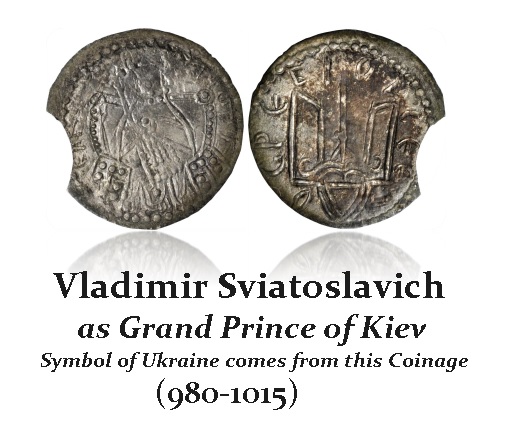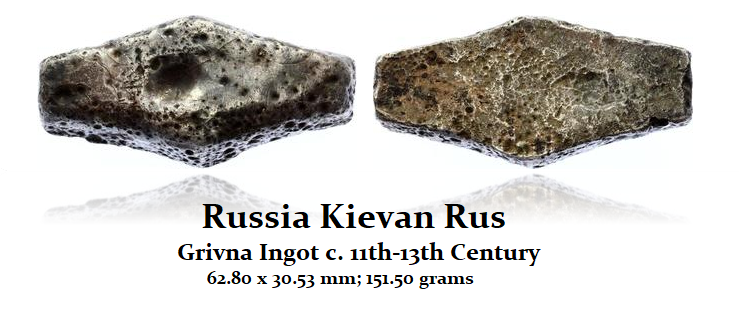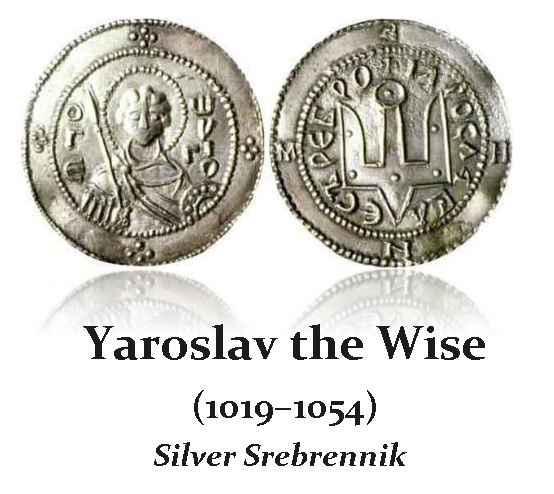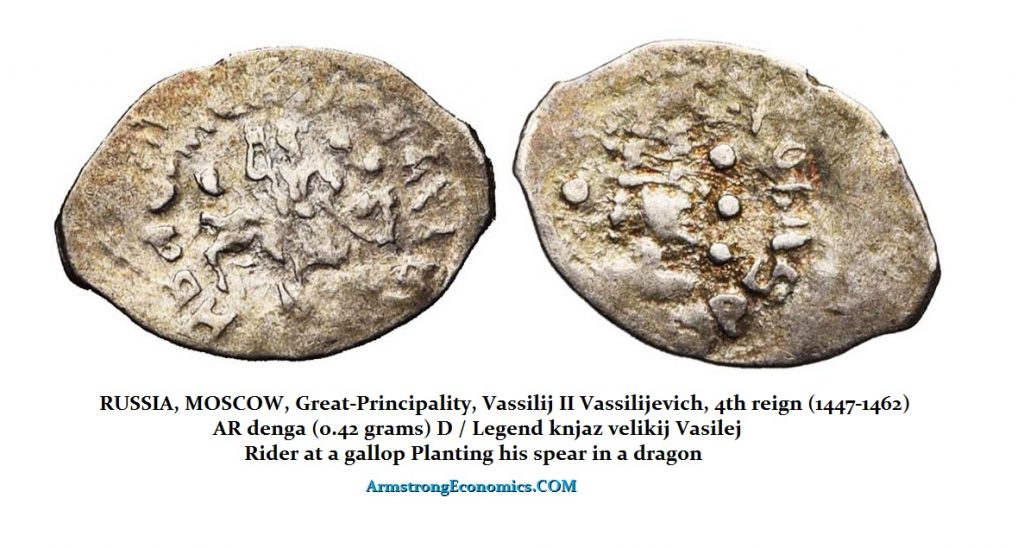Monetary History of
Russia
The Russian Monetary System began also with cattle (skot) during the Kievan period. Skins of small animals and precious metals were used as fixed-value exchange rate based upon barter goods. Up until the end of the 12th century, cattle was the unit of account but commerce took place with the skins of small animals. Actually, furs became the common method of payment for they were valued in terms of cattle, but were much easier for transport and divisibility for small transactions. This made small furs much more suitable for money and they were also an important item of export. Written sources began to speak of such units of payment as kuna (marten’s fur, from kunitsa, a marten), belka or veksha (squirrel), veveritsa (ermine) and nogata (fur with legs, from Arabic nagd, a good or full-value coin), and also of pieces of fur (resana), muzzle furs (mordka) and paw furs (lapka).
The word for silver was “serebro” which became more and more common to denote money as trade with the Byzantine world increased. The Old Russian words kuna and nogata, come from the old “fur money” or “leather money,” thereby retaining their meaning as metal money began to emerge. The names continued in use even though the money began to change to metals given the trade with the Byzantine world. The Rus relied upon foreign-produced money. Both Byzantine silver coins and the silver dirhems of the Arab Caliphate are found in Ukraine and parts of Russia confirming trade existed.
It is clear that there was a change from “fur money” to silver, and the oldest Russian unit of value was the “grivna,” which was based on the Arab coinage system. We only began to find that from the 10th century onwards, local coinage began to be struck, and once this took place, coins became the actual unit of payment in markets. This enabled the expansion of the economy and really the rise of Russia out of the barter age. The “grivna” became both a unit of account and money by weight. Its value equaled that of 96 gold dinars (s[o]lotniki) or 144 silver dirhems (s[e]rebreniki).
However, what coins had been struck were not national coinage but local princes. For about approximately 350-years there were no Russian coins minted. What coins minted between the late-tenth and early-eleventh centuries were by the earliest Christian Kievan princes (of the Rjurikid dynasty), Vladimir (the Great) and his sons, Svjatopolk (the Accursed) and Jaroslav (the Wise), but do not yet represent a “Russian national” coinage. Recent hoards that have been discovered in Western Eurasia clearly reveal that the accepted money supply was mixed with the existence of Western European silver coins such as deniers intermixed with ingots grivny as illustrated here. This constituted the circulating money supply during this period in the Rus’ towns under the Rjurikid princes from the 11th to 14th century.
The ruble has been the Russian unit of currency for about 500 years. It was The monetary reform system instituted by Peter the Great (b 1672;1682-1725) that was a century ahead of most others in that it was based on the decimal system. The basic monetary unit, first coined in 1704, was the silver ruble of 100 kopecks. Other silver coinage consisted of the poltina (one-half ruble), polupoltina (one-fourth ruble), grivennik (ten kopecks), altyn (three kopecks) and kopeck. There were two copper sub-multiples of the kopeck: den’ga (one-half kopeck) and polushka (one-fourth kopeck); and three gold multiples of the ruble: double ruble, chervonets or “ducat” (about 2 and one-half rubles), and dvoinoi chervonets (double chervonets). Unfortunately, Peter’s profligate expenditures steadily eroded most of the value of this otherwise admirable currency. Still, Peter’s reforms made a lasting impact on Russia and many institutions of Russian government traced their origins to his reign.
The amount of precious metal in a ruble varied over time. In a 1704 currency reform, Peter the Great standardized the ruble to 28 grams of silver. While ruble coins were silver, there were higher denominations minted of gold and platinum. By the end of the 18th century, the ruble was set to 4 zolotnik 21 dolya (almost exactly equal to 18 grams) of pure silver or 27 dolya (almost exactly equal to 1.2 grams) of pure gold, with a ratio of 15:1 for the values of the two metals.
In 1817, the ruble was reduced from .986 find gold to .917. This would be further reduced to .900 by Alexander III in 1886. The gold 5 ruble weighed .1929 oz. This was actually nearly the same net weight of the 1802 issue at .986 finess with a net weight of .1928 oz.
In 1825, platinum coins were introduced with 1 ruble equal to 77⅔ dolya (3.451 grams). The denominations were 3, 6, and 12 rubles.
On December 17th, 1885, a new standard was adopted which did not change the silver ruble but reduced the gold content to 1.161 grams, pegging the gold ruble to the French franc at a rate of 1 ruble = 4 francs.
This rate was revised in 1897 to 1 ruble = 2⅔ francs (0.774 grams gold). A 15 ruble gold coin was issued with a weight of .3734 oz. Effectively, this was a revaluation whereas the coin was the same weight as the 10 ruble, wihch had been issued since 1886. The 5 ruble weighing .1867 of an oz under Alexander III from 1886 had been reduced to .1244 oz.
The ruble was worth about .50 USD in 1914.
With the outbreak of World War I, the gold standard peg was dropped and the ruble fell in value, suffering from hyperinflation in the early 1920s. With the founding of the Soviet Union in 1922, the Russian ruble was replaced by the Soviet ruble. The pre-revolutionary Chervonetz was temporarily brought back into circulation from 1922-1925
Before November 1, 1990, the dollar cost 63 kopecks, but there was no opportunity to buy it at such a rate. November 1 of the year 1990 established a commercial rate of 1.8 rubles per dollar. The first trading session was opened on April 9, 1991, in one of the premises of the USSR State Bank, where a blackboard had providently been brought in order to record deals. Following the only concluded transaction (for 50 thousand cashless dollars) the ruble was for the first time ever rated commercially. The real exchange rate of the US dollar against the ruble made up 32.35 rubles per dollar. By the end of the year one dollar was estimated at 169.20 rubles under inflation of about 160% (the percentage is very approximate, as there is no accurate statistics). Prices were set free, people felt lack of products in shops, the USSR collapsed but the Russian Federation hadn’t been formed yet. This period turned to be the time of troubles for former Soviet people.
At the same time stock exchanges entered the market, though the process of their formation was quite spontaneous. The first Russian Exchange was registered in May of 1990 and was called Moscow Commodity Exchange. November 21, 1990, Moscow Central Stock Exchange was the second on the list. The first valuable securities trading session in the USSR was held only several months later.
In general by the end of 1991 Russia registered 182 commodity and stock exchanges. The RF left behind the whole planet by number of exchanges and variety of concluded transactions. That time Russian exchanges used to trade any possible commodities and security papers. When the Soviet supply system wrecked, exchanges took on a role as middlemen. The majority of goods were in deficit, even money: the president of the State Bank complained in his secret letter to M.S. Gorbachev that the Finance department failed to mint enough money to keep pace with inflation.
New Russian exchanges traded wood, sugar, paper, building materials, cars, computers and even bread! Very soon Russia numbered over 1000 exchanges, though most of them couldn’t be called traditional stock structures, as essentially they operated as trade fairs.
First rare bidders had to face an absolute lack of legislation regulating trading sessions and transactions. One of the most intrinsic legislative initiatives of 1990 happened to be the Commodity Exchange Activity Resolution of the RSFSR Cabinet Council. The resolution maintained the order of exchanges’ registration and heir functions. The distinctive feature of laws passed then is their laconism. The most significant laws regulating the stock market appeared in December of 1991.
Despite the chaos ruling the market after the USSR collapse, there had already existed companies, which later came to prominence. It’s hard to define the field of their activity then, but it is known that January 18, 1991, the today’s Russian leading investment company Troika Dialog was founded, and in 1991 the information agency AK&M was established.
Princes of Novgorod
Rurik (b ?-879; 862-879)
Oleg of Novgorod (regent) (b ?-912)
Grand Princes of Kiev
Askold and Dir (non-Rurikids) (b ?-882; 842/862-882)
Oleg of Novgorod (regent) (b ?-912)
Igor I (b ?-945; 913-945)
Saint Olga of Kiev (regent) (b ?-969)
Sviatoslav I the Great (b 942–972; 962-972)
Yaropolk I (b 958/960–980; 972-980)
Saint Vladimir I the Great (b 958–1015; 978-1015)
Sviatopolk I the Accursed (b 980–1019; 1015-1016)
Yaroslav I the Wise (b 978–1054; 1016-1018)
Sviatopolk I the Accursed (b 980–1019; 1018-1019)
Yaroslav I the Wise (b 978–1054; 1019-1054)
Iziaslav I (b 1024–1078; 1054-1068)
Vseslav of Polotsk (b 1039–1101; 1068-1069)
Iziaslav I (b 1024–1078; 1069-1073)
Sviatoslav II (b 1027–1076; 1073-1076)
Vsevolod I (b 1030–1093; 1077-1077)
Iziaslav I (b 1024–1078; 1077-1078)
Vsevolod I (b 1030–1093; 1078-1093)
Sviatopolk II (b 1050–1113; 1093-1113)
Vladimir II Monomakh (b 1053–1125; 1113-1125)
Mstislav the Great (b 1076–1132; 1125-1132)
Yaropolk II (b 1082–1139; 1132-1139)
Viacheslav I (b 1083/2-1154; 1139-1139)
Vsevolod II (b ?-1146; 1139-1146)
Igor II (b ?-1146; 1146-1146)
Iziaslav II Panteleimon (b 1097–1154; 1146-1149)
Yuri I the Long Arms (b 1099–1157; 1149-1150)
Viacheslav I (b 1083/2-1154; 1150-1150)
Iziaslav II Panteleimon (b 1097–1154; 1150-1150)
Yuri I the Long Arms (b 1099–1157; 1150-1151)
Iziaslav II Panteleimon (b 1097–1154; 1151-1154)
Viacheslav I (b 1083/2; 1151-1154)
Rostislav I (b 1110–1167; 1154-1155)
Iziaslav III (b ?-1162; 1155-1155)
Yuri I the Long Arms (b 1099–1157; 1155-May 15, 1157)
Iziaslav III (b ?-1162; May 1157-December 1158)
Mstislav II (b 1125–1170; December 1158-Spring 1159)
Rostislav I (b 1110–1167; April 1159-February 1161)
Iziaslav III (b ?-1162; February 1161-March 1161)
Rostislav I (b 1110–1167; March 1161-March 1167)
Vladimir III (b 1132–1173; Spring 1167-Spring 1167)
Mstislav II (b 1125–1170; May 1167-March 1169)
Grand Princes of Vladimir
Saint Andrei I Bogolyubsky (b 1110–1174; May 1157-June 1174)
Mikhail I (b ?-1176; 1174 September 1174)
Yaropolk (b ?-after 1196; 1174-June 1175)
Mikhail I (b ?-1176; June 1175-June 1176)
Vsevolod III the Big Nest (b 1154–1212; June 1176-April 1212)
Yuri II (1189–1238; 1212-April 1216)
Konstantin of Rostov (b 1186–1218; Spring 1216-February 1218)
Yuri II (b 1189–1238; February 1218-March 1238)
Yaroslav II (b 1191–1238; 1238-September 1246)
Sviatoslav III (b 1196–1252; 1246 1248)
Mikhail Khorobrit (b 1229–1248; 1248-January 15, 1248)
Sviatoslav III (b 1196–1252; 1248-1249)
Andrey II (b 1221–1264; December 1249-July 1252)
Saint Alexander I Nevsky (b 1220–1263; 1252-November 1263)
Yaroslav III (b 1230–1272; 1264-1271)
Vasily of Kostroma (b 1241–1276; 1272-January 1277)
Dmitry of Pereslavl (b 1250–1294; 1277-1281)
Andrey III (b 1255–1304; 1281-December 1283)
Dmitry of Pereslavl (b 1250–1294; December 1283-1293)
Andrey III (b 1255–1304; 1293-1304)
Saint Michael of Tver (b 1271–1318; 1304-November 1318)
Yuri (III) of Moscow (b 1281–1325; 1318-November 1322)
Dmitry I the Terrible Eyes (b 1299–1326; 1322-September 1326)
Alexander of Tver (b 1281–1339; 1326-1327)
Alexander of Suzdal (b ?–1331; 1327-1328)
Ivan I of Moscow Kalita (b 1288–1340; 1328-March 1340)
Grand Princes of Moscow
Ivan I Kalita (b 1288; November 1325-March 1340)
Simeon the Proud (b 1316; 1340-1353)
Ivan II the Handsome (b 1326; April 1353-November 1359)
Saint Dmitry I Donskoy (b 1350; November 1359- May 1389)
Vasily I (b December 1371; May 1389-February 1425)
Vasily II the Blind (b 1415; February 1425-March 1462)
Ivan III the Great (b 1440; April 1462-November 1505)
Vasily III (b 1479; November 1505-December 1533)
House of Rurikovich
Ivan IV the Terrible (b 1530; January 1547-March 1584)
Feodor I (b 1557; March 1584-January 1598)
House of Godunov
Irina (disputed) (b 1557?; Feodor I’s daughter January 7-15, 1598; d October 1603)
Boris I (b 1551?; February 1598-April 1605)
Feodor II (b 1589; April 1605-June 1605)
Pseudo-Rurikovich usurpers
False Dmitry I (Grigory Bogdanovich Otrepyev) (b 1581?; June 1605-May 1606)
False Dmitry II (b. 1582?; July 1607-December 1610)
False Dmitry III (Sidorka) (b ?; March 1611-May 1612)
House of Shuysky
Vasiliy IV (b 1552; May 1606-July 1610)
House of Vasa
Vladislav I (b 1595; September 1610-November 1612 (deposed))
House of Romanov
Michael I (b 1596; July 1613-July 1645)
Alexis I the Quietest (b 1629; July 1645-January 1676)
Feodor III (b 1661; January 1676-May 1682)
Sophia (regent) (b September 1657; May 1682-August 1689; d July 1704)
Ivan V jointly with Peter I (b September 1666; June 1682-February 1696)
Emperors of Russia
(Also Grand Princes of Finland from 1809 until 1917; and Kings of Poland from 1815 until 1917)
Peter I the Great (b June 1672; with Ivan V 1682–1696; June 1682-November 1721; February 1725, St. Petersburg, Russian Empire)
Catherine I (b April 1684; February 1725-May 1727)
Peter II (b 1715; May 1727-January 1730)
Anna (b 1693; February 1730-October 1740)
Ivan VI (disputed) (b 1740; October 1740-December 1741; murdered July 1764)
Shlisselburg, Russian Empire
Elizabeth (b 1709; December 1741-January 1762)
Peter III (b 1728; January 1762-July 1762 (murdered))
Catherine II the Great (b 1729; July 1762-November 1796)
Paul I (b 1754; November 1796-March 1801 (assassinated))
Alexander I the Blessed (b 1777; March 1801-December 1825)
Constantine I (disputed) (b 1779; December 1-26, 1825) d June 27, 1831)
Nicholas I (b 1796; December 1825-March 1855)
Alexander II the Liberator (b 1818; March 1855-March 1881 (assassinated))
Alexander III the Peace-Maker (b 1845; March 1881-November 1894)
Saint Nicholas II (b 1868; November 1894-March 1917; July 17, 1918 (executed))
Michael II (disputed) (b 1878; March 15-16 March 1917; June 12, 1918 (murdered))















